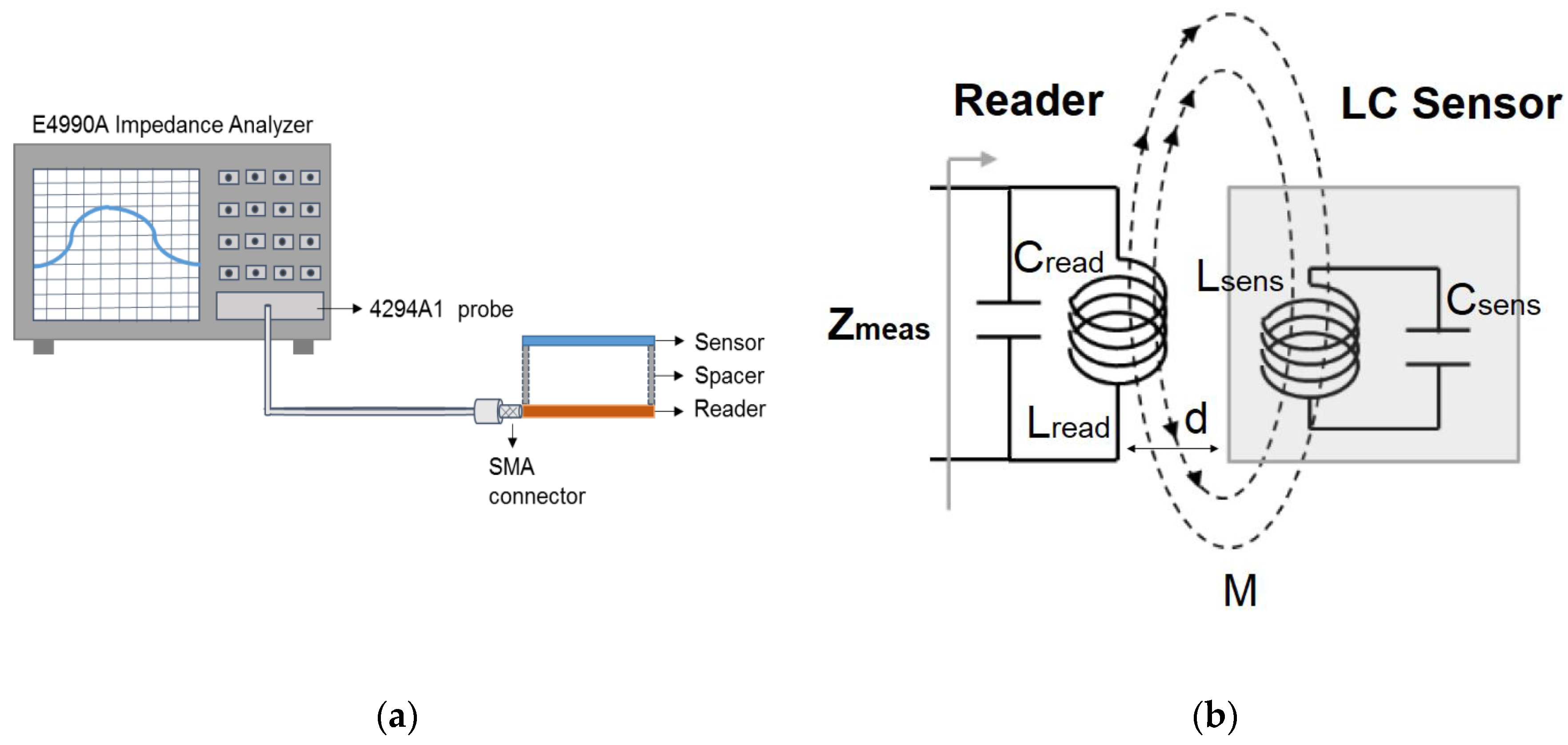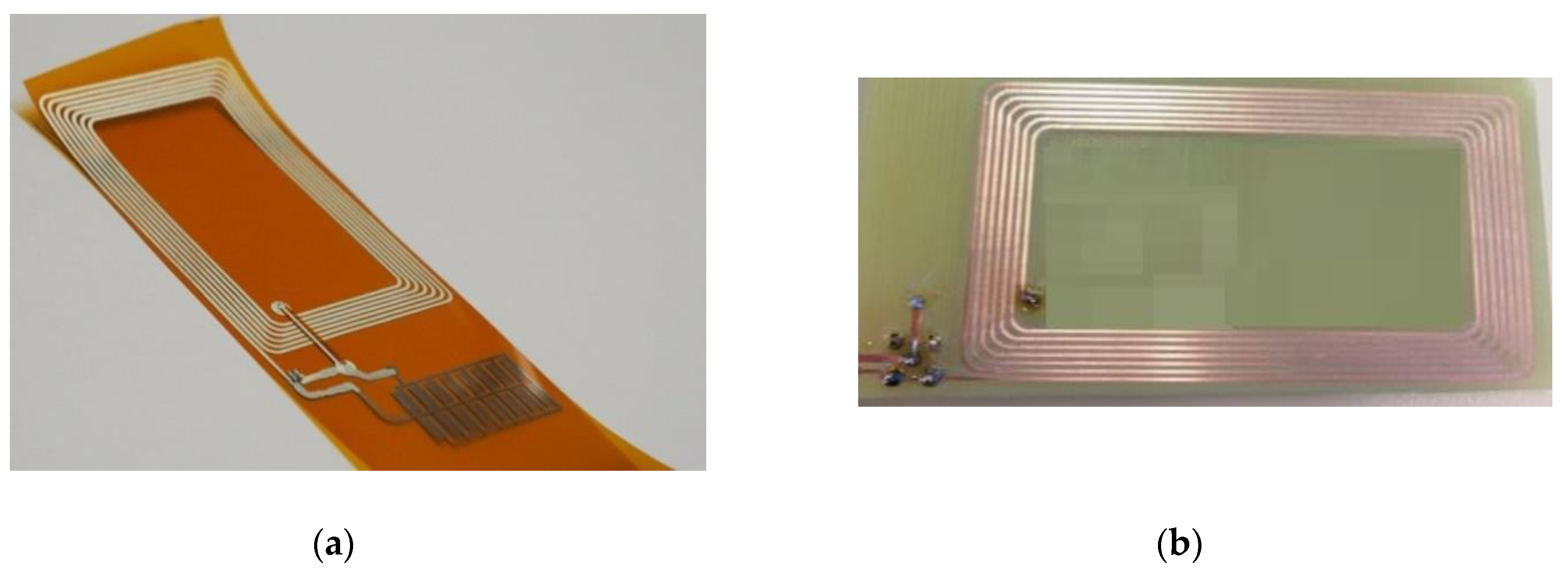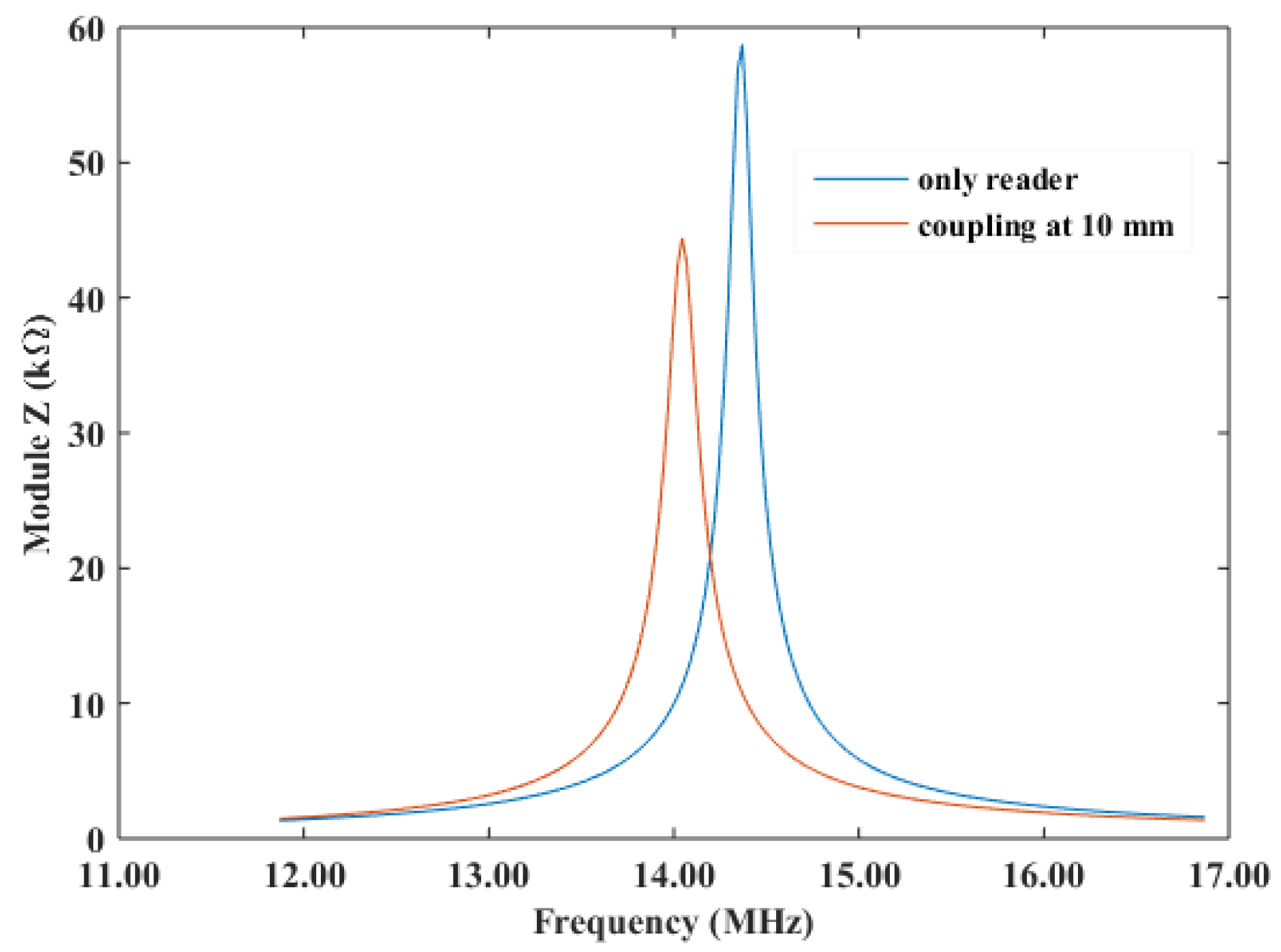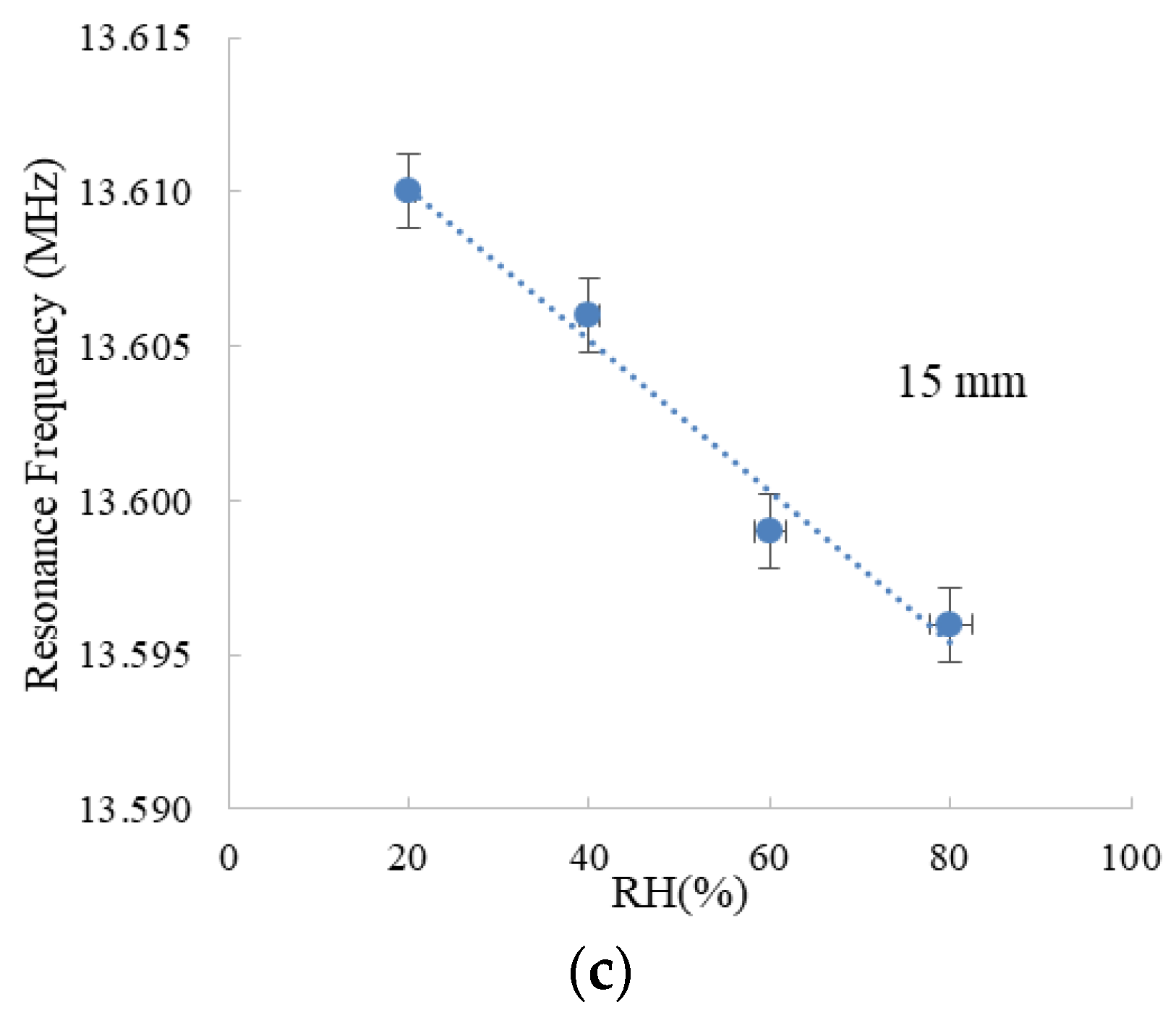Wireless Chipless System for Humidity Sensing
Abstract
:1. Introduction
2. Materials and Methods
2.1. Design and Working Principle
2.2. Materials and Fabrication Process
2.3. Characterization
3. Results and Discussion
3.1. Reader Characterization
3.2. Humidity Behavior
3.3. Temperature Influence
4. Conclusions
Author Contributions
Funding
Acknowledgments
Conflicts of Interest
References
- Babar, A.A.; Manzari, S.; Sydanheimo, L.; Elsherbeni, A.Z.; Ukkonen, L. Passive UHF RFID Tag for Heat Sensing Applications. IEEE Trans. Antennas Propag. 2012, 60, 4056–4064. [Google Scholar] [CrossRef]
- Bhattacharyya, R.; Floerkemeier, C.; Sarma, S. Low-cost, ubiquitous RFID-tag-antenna-based sensing. Proc. IEEE 2010, 98, 1593–1600. [Google Scholar] [CrossRef]
- Cazeca, M.J.; Mead, J.; Chen, J.; Nagarajan, R. Passive wireless displacement sensor based on RFID technology. Sens. Actuators A Phys. 2013, 190, 197–202. [Google Scholar] [CrossRef]
- Daliri, A.; Galehdar, A.; John, S.; Wang, C.H.; Rowe, W.S.T.; Ghorbani, K. Wireless strain measurement using circular microstrip patch antennas. Sens. Actuators A Phys. 2012, 184, 86–92. [Google Scholar] [CrossRef]
- Jacquemod, G.; Nowak, M.; Colinet, E.; Delorme, N.; Conseil, F. Novel architecture and algorithm for remote interrogation of battery-free sensors. Sens. Actuators A Phys. 2010, 160, 125–131. [Google Scholar] [CrossRef]
- Li, X.Y.; Kan, E.C. A wireless low-range pressure sensor based on P(VDF-TrFE) piezoelectric resonance. Sens. Actuators A Phys. 2010, 163, 457–463. [Google Scholar] [CrossRef] [Green Version]
- Nilsson, H.-E.; Unander, T.; Siden, J.; Andersson, H.; Manuilskiy, A.; Hummelgard, M.; Gulliksson, M. System Integration of Electronic Functions in Smart Packaging Applications. IEEE Trans. Compon. Packag. Manuf. Technol. 2012, 2, 1723–1734. [Google Scholar] [CrossRef]
- Yi, X.; Cho, C.; Cooper, J.; Wang, Y.; Tentzeris, M.M.; Leon, R.T. Passive wireless antenna sensor for strain and crack sensing—Electromagnetic modeling, simulation, and testing. Smart Mater. Struct. 2013, 22. [Google Scholar] [CrossRef]
- Zhang, C.; Wang, L.-F.; Huang, J.-Q.; Huang, Q.-A. An LC-type passive wireless humidity sensor system with portable telemetry unit. J. Microelectromech. Syst. 2015, 24, 575–581. [Google Scholar] [CrossRef]
- Huang, Q.-A.; Dong, L.; Wang, L.-F. LC Passive Wireless Sensors Toward a Wireless Sensing Platform: Status, Prospects, and Challenges. J. Microelectromech. Syst. 2016, 25, 822–841. [Google Scholar] [CrossRef]
- Li, C.; Tan, Q.; Zhang, W.; Xue, C.; Xiong, J. An embedded passive resonant sensor using frequency diversity technology for high-temperature wireless measurement. IEEE Sens. J. 2015, 15, 1055–1060. [Google Scholar]
- Li, C.; Tan, Q.-L.; Xue, C.-Y.; Zhang, W.-D.; Li, Y.-Z.; Xiong, J.-J. Wireless contactless pressure measurement of an LC passive pressure sensor with a novel antenna for high-temperature applications. Chin.Phys. B 2015, 24. [Google Scholar] [CrossRef]
- Tan, Q.; Ren, Z.; Cai, T.; Li, C.; Zheng, T.; Li, S.; Xiong, J. Wireless passive temperature sensor realized on multilayer HTCC tapes for harsh environment. J. Sens. 2015, 2015. [Google Scholar] [CrossRef]
- Bhadra, S.; Blunt, W.; Dynowski, C.; McDonald, M.; Thomson, D.J.; Freund, M.S.; Cicek, N.; Bridges, G.E. Fluid embeddable coupled coil sensor for wireless pH monitoring in a bioreactor. IEEE Trans. Instrum. Meas. 2014, 63, 1337–1346. [Google Scholar] [CrossRef]
- Shi, Q.; Wang, J.; Chen, D.; Chen, J.; Li, J.; Bao, K. In Vitro and In Vivo characterization of wireless and passive micro system enabling gastrointestinal pressure monitoring. Biomed. Microdevices 2014, 16, 859–868. [Google Scholar] [CrossRef] [PubMed]
- Zhang, H.; Hong, Y.; Ge, B.; Liang, T.; Xiong, J. A novel readout system for wireless passive pressure sensors. Photonic Sens. 2014, 4, 70–76. [Google Scholar] [CrossRef] [Green Version]
- Nopper, R.; Niekrawietz, R.; Reindl, L. Wireless readout of passive LC sensors. IEEE Trans. Instrum. Meas. 2010, 59, 2450–2457. [Google Scholar] [CrossRef]
- Nopper, R.; Has, R.; Reindl, L. A wireless sensor readout system—Circuit concept, simulation, and accuracy. IEEE Trans. Instrum. Meas. 2011, 60, 2976–2983. [Google Scholar] [CrossRef]
- Suganuma, K. Introduction to Printed Electronics; Springer Science & Business Media: Berlin, Germany, 2014; Volume 74. [Google Scholar]
- Fernandez-Salmeron, J.; Rivadeneyra, A.; Carvajal Rodriguez, M.A.; Capitan-Vallvey, L.F.; Palma, A.J. HF RFID Tag as Humidity Sensor: Two Different Approaches. IEEE Sens. J. 2015, 15, 5726–5733. [Google Scholar] [CrossRef]
- Wang, X.; Larsson, O.; Platt, D.; Nordlinder, S.; Engquist, I.; Berggren, M.; Crispin, X. An all-printed wireless humidity sensor label. Sens. Actuators B Chem. 2012, 166, 556–561. [Google Scholar] [CrossRef] [Green Version]
- Lehpamer, H. RFID Design Principles; Artech House: Norwood, MA, USA, 2012. [Google Scholar]
- Nasser, Y.A.; Bazzoun, M.A.; Hijazi, H.; Al Ghouwayel, A. Modeling and design of NFC/RFID backbone using a Computer Aided Design tool. In Proceedings of the 2016 Sixth International Conference on Digital Information Processing and Communications (ICDIPC), Beirut, Lebanon, 21–23 April 2016; pp. 162–167. [Google Scholar]
- Salmerón, J.F.; Molina-Lopez, F.; Briand, D.; Ruan, J.J.; Rivadeneyra, A.; Carvajal, M.A.; Capitán-Vallvey, L.; de Rooij, N.F.; Palma, A.J. Properties and Printability of Inkjet and Screen-Printed Silver Patterns for RFID Antennas. J. Electron. Mater. 2014, 43, 604–617. [Google Scholar] [CrossRef]
- White, J.F. High Frequency Techniques: An Introduction to RF and Microwave Engineering; John Wiley & Sons: Hoboken, NJ, USA, 2004. [Google Scholar]
- Haobijam, G.; Palathinkal, R.P. Design and Analysis of Spiral Inductors; Springer: Berlin, Germany, 2014. [Google Scholar]
- DupontTM, Kapton Datasheet, (Kapton® Polyimide Film Datasheet). Available online: http://www.dupont.com/content/dam/dupont/products-and-services/membranes-and-films/polyimde-films/documents/DEC-Kapton-HN-datasheet.pdf (accessed on 12 July 2018).
- Le, G.T.; Tran, T.V.; Lee, H.-S.; Chung, W.-Y. Long-range batteryless RF sensor for monitoring the freshness of packaged vegetables. Sens. Actuators A Phys. 2016, 237, 20–28. [Google Scholar] [CrossRef]
- Huang, C.-F.; Huang, Y.-F. Design of RFID reader antenna for exclusively reading single one in tag assembling production. Int. J. Antennas Propag. 2012, 2012, 2012. [Google Scholar] [CrossRef]
- Siden, J.; Zeng, X.; Unander, T.; Koptyug, A.; Nilsson, H.-E. Remote moisture sensing utilizing ordinary RFID tags. In Proceedings of the IEEE Sensors, Atlanta, GA, USA, 28–31 October 2007; IEEE: Wilmington, MA, USA, 2007; pp. 308–311. [Google Scholar]
- Andersson, H.; Hammarling, K.; Sidén, J.; Manuilskiy, A.; Öhlund, T.; Nilsson, H.-E. Modified EAS tag used as a resistive sensor platform. Electronics 2012, 1, 32–46. [Google Scholar] [CrossRef]
- Raju, S.; Wu, R.; Chan, M.; Yue, C.P. Modeling of mutual coupling between planar inductors in wireless power applications. IEEE Trans. Power Electron. 2014, 29, 481–490. [Google Scholar] [CrossRef]
- Marioli, D.; Sardini, E.; Serpelloni, M.; Taroni, A. A new measurement method for capacitance transducers in a distance compensated telemetric sensor system. Meas. Sci. Technol. 2005, 16. [Google Scholar] [CrossRef]
- Marioli, D.; Sardini, E.; Serpelloni, M.; Taroni, A. A distance compensated telemetric humidity sensor based on the parasitic capacitance variation. In Proceedings of the Instrumentation and Measurement Technology Conference (IMTC), Sorrento, Italy, 24–27 April 2006; IEEE: Wilmington, MA, USA, 2006; pp. 655–660. [Google Scholar]
- Marioli, D.; Sardini, E.; Serpelloni, M.; Taroni, A. Contactless transmission of measurement information between sensor and conditioning electronics. IEEE Trans. Instrum. Meas. 2008, 57, 303–308. [Google Scholar] [CrossRef]
- Deen, D.A.; Olson, E.J.; Ebrish, M.A.; Koester, S.J. Graphene-based quantum capacitance wireless vapor sensors. IEEE Sens. J. 2014, 14, 1459–1466. [Google Scholar] [CrossRef]
- Zhang, C.; Guo, L.; Wang, L.-F.; Huang, J.-Q.; Huang, Q.-A. Passive wireless integrated humidity sensor based on dual-layer spiral inductors. Electron. Lett. 2014, 50, 1287–1289. [Google Scholar] [CrossRef]
- Feng, Y.; Xie, L.; Chen, Q.; Zheng, L.-R. Low-cost printed chipless RFID humidity sensor tag for intelligent packaging. IEEE Sen. J. 2015, 15, 3201–3208. [Google Scholar] [CrossRef]





| Distance (mm) | Freq. Change (kHz) | Sensitivity (Hz/%RH) |
|---|---|---|
| 10 | 148 | −2.60 × 103 |
| 15 | 21 | −0.30 × 103 |
| 20 | 14 | −0.20 × 103 |
| Distance (mm) | RH (%) | Freq. Change (kHz) |
|---|---|---|
| 10 | 50 | 18 kHz |
| 15 | 50 | 8 kHz |
| 10 | 70 | 30 kHz |
| 15 | 70 | 24 kHz |
| Reference | Fabrication Technology | Materials | Area (cm2) | Sensitivity (kHz/%RH) | Range RH (%) | Distance * (mm) | Temp. (°C) |
|---|---|---|---|---|---|---|---|
| Deen et al. 2014 [36] | Plasma enhanced Chemical Vapour Deposition | Graphene, Cu | <1 | 5.7 | 1–97 | -- | 23 |
| Zang et al. 2014 [37] | Spin-coating, patterning | Polyimide, Al | <1 | 65 | 10–95 | 0 | 25 |
| Zang et al. 2015 [9] | CMOS technology and standard PCB process | GO, Cu | <1 | −18.75 | 15–95 | -- | 25 |
| Feng et al. 2015 [38] | Inkjet printing | Paper, polyimide, PET | 8 | 370 | 20–90 | -- | 25 |
| Wang et al. 2012 [21] | Dry-phase milling process, screen printing | Polyelectrolyte, Ag, carbon | 100 | −1.06 | 30–90 | 0 | 23 |
| Fernandez-Salmeron et al. 2015 [20] | Screen printing, inkjet printing | Polyimide, Ag | 40 | −3.7 | 15–95 | -- | 10–55 |
| This work | Screen printing, inkjet printing | Polyimide, Ag | 40 | −2.60 to −0.20 | 20–80 | 10–20 | 10–55 |
© 2018 by the authors. Licensee MDPI, Basel, Switzerland. This article is an open access article distributed under the terms and conditions of the Creative Commons Attribution (CC BY) license (http://creativecommons.org/licenses/by/4.0/).
Share and Cite
Salmerón, J.F.; Albrecht, A.; Kaffah, S.; Becherer, M.; Lugli, P.; Rivadeneyra, A. Wireless Chipless System for Humidity Sensing. Sensors 2018, 18, 2275. https://doi.org/10.3390/s18072275
Salmerón JF, Albrecht A, Kaffah S, Becherer M, Lugli P, Rivadeneyra A. Wireless Chipless System for Humidity Sensing. Sensors. 2018; 18(7):2275. https://doi.org/10.3390/s18072275
Chicago/Turabian StyleSalmerón, José F., Andreas Albrecht, Silmi Kaffah, Markus Becherer, Paolo Lugli, and Almudena Rivadeneyra. 2018. "Wireless Chipless System for Humidity Sensing" Sensors 18, no. 7: 2275. https://doi.org/10.3390/s18072275





